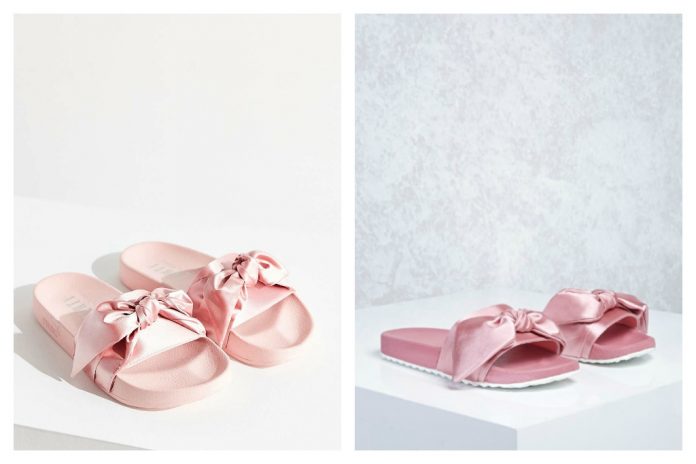This article has been written by Rhea Jain, from the Northcap University, Gurugram.
Table of Contents
Introduction
“To be irreplaceable, one must always be unique.”- Coco Chanel
In March 2017, Puma filed a lawsuit against Forever 21 in the District Court of California, US, claiming that the brand Forever 21 infringed on Puma’s plan patent, exchange dress, and copyright by duplicating its Fenty shoe range. Since Puma’s Creeper Sneaker, Fur Slide, and Bow Slide were designed by renowned Barbadian vocalist Robyn Rihanna Fenty, these sneakers and slip-on shoes have been dubbed “Fenty shoes.”
Versace’s medusa motif, Vera Wang’s wedding gown, and Dr. Martens boots are all examples of intellectual creativity and talent applied in the fashion industry. Nobody can deny the enormous value of intellectual capital in the creation and marketing of products in the fashion industry, whether high fashion or ready-to-wear. Nonetheless, many small and medium-sized businesses pay little, if any, attention to protecting such intellectual assets. In today’s business environment, innovative thinking and unique creative expressions are the primary sources of competitive advantage for all businesses, including those in the fashion industry.
Intellectual Property is the law that refers to the creation of the creator’s mind like inventions, designs, symbols, literary or artistic work or any other names used. It is protected by copyright law, patent law and trademarks which help such a creator to protect his work and gain recognition, financially or not, and such an aim in a better environment for more of such innovations and creativity by other people. Fashion Law is a new legal speciality that encompasses a wide range of legal issues, from intellectual property to contracts to company law and policies. It is as exciting as it is technical because it consists of various laws that you will need at your fingertips to provide a comprehensive solution. Almost every day, lawsuits are filed defeating fashion brands and their intellectual property against one another and in some cases, such as when sportswear giants are involved, these disputes are seemingly only increasing in frequency. Given a large number of fashion intellectual property cases on the courts’ list across the country, and internationally, some stand out more than others in terms of the potential ramifications for the companies involved and the fashion industry as a whole.
Brand equity is important to major fashion houses. Most businesses form bonds with their customers through their brand names, which they fiercely protect through trademark registration and copyright law protection of associated artwork. Trademarks are equally important for a small or start-up fashion company. Teenagers and shopping enthusiasts consider the brand’s fashion logo to be trendy and are willing to pay a premium for clothing bearing its trademark. Today, the company outsources manufacturing and focuses on marketing, distribution, and monitoring and controlling trademark usage.
In this article we will discuss the case of Puma, a German multinational corporation headquartered in Herzogenaurach, Bavaria, Germany, that designs and manufactures athletic and casual footwear, apparel, and accessories and Forever 21, a Los Angeles, California-based American fast-fashion retailer.
Facts of the case
Rihanna, the world-renowned music artist, had served as the Women’s Creative Director for Puma clothing and footwear since December 2014. Rihanna has served as a brand ambassador for Puma’s “Fenty” label in this capacity. As the Fenty products were luxury items, Puma kept the volume small and the sales limited in order to create desirability not only for the Fenty products but also for the Puma brand.
Puma created and released the Puma by Rihanna ‘Creeper’ Sneaker in 2015 as part of this footwear line. The overall design of the shoe, which includes suede uppers and a thick rubber outer sole with ridged tooling and a grainy texture, distinguishes the “Creeper” from other footwear on the market. Puma released the “Fur Slide” sandal in April 2016, following the success of the “Creeper.” In March 2017, the “Fur Slide” was followed by the “Bow Slide.” Puma’s “Creeper” sneaker, “Fur Slide” and “Bow Slide” sandals (collectively known as the “Fenty Shoes”) have achieved significant and notable success. The Fenty Shoes have also received significant uninvited media attention, including coverage in Vanity Fair, W Magazine, Allure, Vogue, and Harper’s Bazaar.
Puma’s Fenty Shoes are protected by a variety of intellectual property rights. To protect its intellectual property in Fenty Shoes, Puma has a robust international enforcement programme. Puma recently obtained an injunction against the German retailer Top Shop, preventing it from selling knock-offs of the Fenty Shoes. Forever 21 blatantly copied (or “knocked-off”) each of these shoes in order to capitalise on the substantial goodwill of Puma, Rihanna, and the Fenty Shoes.
Forever 21 had released a variety of shoes under its image name. Later in March 2017, Puma filed a lawsuit against Forever 21 in a District Court in California, the United States, claiming that the designs of the shoes produced by Forever 21 were similar to those of Puma’s Creeper Sneaker, Fur Slide, and Bow Slide under the Fenty assortment (planned by a renowned vocalist Rihanna Fenty). As a result, they had infringed on Puma’s plan patent.
The causes of action were as follows:
- Design patent infringement;
- Federal Trade dress infringement;
- Copyright infringement;
- Federal false designation of origin; and
- State unfair competition (Cal. Bus. & Prof. Code §17200).
Regardless, Forever 21 looked for a sliver of an excuse to claim that the plans weren’t new to the puma; in reality, they date back to the mid-twentieth century.
Issue
Should Forever 21’s motion to dismiss be granted?
Judgement
While Puma publicly advertises that Rihanna designed the shoe at issue in this litigation, Rihanna wasn’t named as an artist on Puma’s copyright applications or as an investor on Puma’s design patent, according to Judge Phillip Gutierrez. He obtained two possible outcomes from this – either Puma distorted material realities to the Patent and Copyright office, thereby submitting misrepresentation there, or they distorted the public that Rihanna designed the shoes, thereby distorting the courts that her contribution impacts the generosity associated with the exchange.
Cause 1
Puma has signed a patent that guarantees the design of the shoe being mentioned for the first cause of activity. It must demonstrate the following:
- charge responsibility for a patent;
- name each litigant;
- request the patent;
- express the methods by which 6 litigants allegedly infringe; and
- highlight the segments of jurisprudence summoned.
Furthermore, Puma meets all of the requirements and disputes ownership, claiming Forever 21 copied their plan.
Cause 2
Puma also asserted its second reason for an activity for exchange dress encroachment for all of the previously mentioned shoes. The term “exchange dress” refers to the entire picture and how something appears. It could include shape, size, shading, and so on in the case of an item or clothing. Thus, Forever 21 claims that Puma has failed to demonstrate that the exchange dress is practical, and thus, the court dismisses the case.
Cause 3
For the third reason for activity: to ensure copyright infringement, Puma must demonstrate:
- responsibility for copyright.
- duplication of the essential components of the primary work.
Forever 21 expresses to make a case for this reason due to reasons:
- Puma’s copyright applications aren’t sufficient.
- The shoe plans aren’t ones to be copyrighted because the plan wasn’t their unique creation.
Cause 4
For the fourth reason for activity: Puma’s fourth reason for activity remembered bogus assignment of start line for Lanham Act infringement.
Cause 5
The fifth reason for activity included unjustifiable rivalry under Cal.Bus. and Prof. Code. Forever 21 rationalises both the rationale for an activity and the explanations behind exchange dress encroachment but fizzle.
The movement provided by Forever 21 was allowed to a limited extent and denied to some extent:
- Puma’s first reason for a trade dress infringement activity was denied.
- Puma’s second reason for a trade dress infringement activity was granted with leave to change.
- The third reason for an activity for copyright infringement was granted, with leave to correct.
- The fourth reason for an activity under the Langan Act for bogus assignment of the start line and out of line rivalry, with leave to change.
- The fifth reason for an activity for violation of the UCL was granted.
The Judgment was, therefore, not in favour of Puma. Forever 21 filed a motion in court in 2018 asking for the dismissal of Puma’s patent claim because the shoe design is influenced by the 1940s. It also claimed that Puma committed fraud in its filings with the United States Patent and Trademark Office and the Copyright Office, and that while Puma publicly tries to promote that Rihanna designed the shoes at issue in this lawsuit, Rihanna is not named as an author on Puma’s copyright applications or as an inventor on Puma’s design patent.
The intellectual property conflict between fashion retailer Forever 21 and sportswear company Puma has ceased after both the parties agreed to settle.
Conclusion
Certain design elements in each style are protected by copyright. For example, the Creeper’s ridged vertical tooling and grainy texture encircling the thick rubber outer sole, or the Bow Slide’s thick sandal base embellished with a wide, casually knotted satin bow with pointed endings atop the side strap, as well as satin foam backing. Puma’s success, as in other plan infringement cases, was entirely dependent on how well it secures and upholds its plans. So far, Puma has guaranteed that it created the plans; consequently, unregistered plan rights, like all plans, would provide an infinite supply of the plans. More importantly, Puma owns the enrolled plan rights to the Creeper plan in the United States. It is unclear whether Puma has enrolled in any other proposals.
It is, therefore, important to register your plans. When your plan is a critical component of a product, model, or drawing, it’s usually a good idea to enlist the help of an idea selection to ensure its success. Originators or creators attempting to find a public, for example, UK, application for plan insurance should specifically comply with various enrolment conditions. If an indistinguishable plan, drawing, example, or model has recently been made available to the general public, this test will fail. The plan does not have to be aesthetically pleasing in order for it to be accepted; however, an application will be rejected if it is entirely dependent on how the thing functions.
It must have a ‘unique character’. It must be feasible for a supposed ‘educated client’ to recognise the new plan and a pretty similar item. If the supposed educated client believes that the item configuration gives the same general impression as an idea that has recently been made available to the general public, it will not have enough ‘singular character’ to be qualified for assurance.
Infringers are no longer replicating exact designs, but they are close enough to confuse purchasers. While IP attorneys are becoming more widely available, it is still a costly method; stuffed full owners complain that the process of obtaining and enforcing a court injunction is currently too time-consuming. They want the government to take strong, greater punitive action against IP infringers in the textile industry in order to give design protection legislation teeth and prevent further widespread replication.
Protecting the said intellectual capital in the form of IP assets increases income through the sale, licences, and commercialization of differentiated new products, improves market share, increases profit margins, and lowers the risk of infringing on the intellectual property rights of others. A good IP asset management strategy in a business or marketing plan helps to increase an enterprise’s value in the eyes of investors and lending institutions.
References
- https://www.justvocateslaw.com/post/puma-vs-forever-21-case-analysis
- https://www.latestlaws.com/intellectual-property-news/know-how-forever-21-and-puma-finally-settled-their-copyright-infringement-dispute/
- https://www.courthousenews.com/wp-content/uploads/2017/04/Puma-Forever-21.pdf
- https://www.mondaq.com/india/patent/759498/forever-in-ip-news-f-21-and-puma-settle-over-slides
LawSikho has created a telegram group for exchanging legal knowledge, referrals, and various opportunities. You can click on this link and join:












